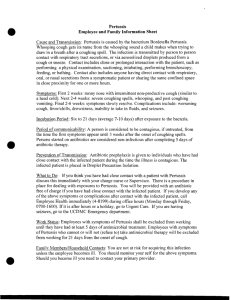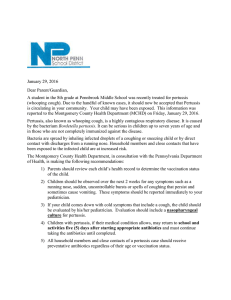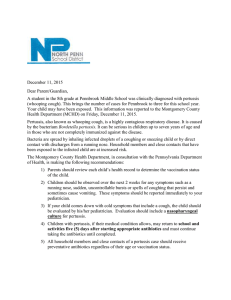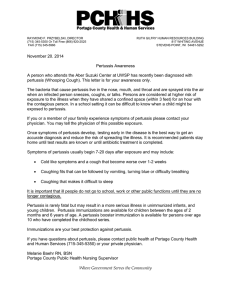pertussis surveillance and response protocol
advertisement
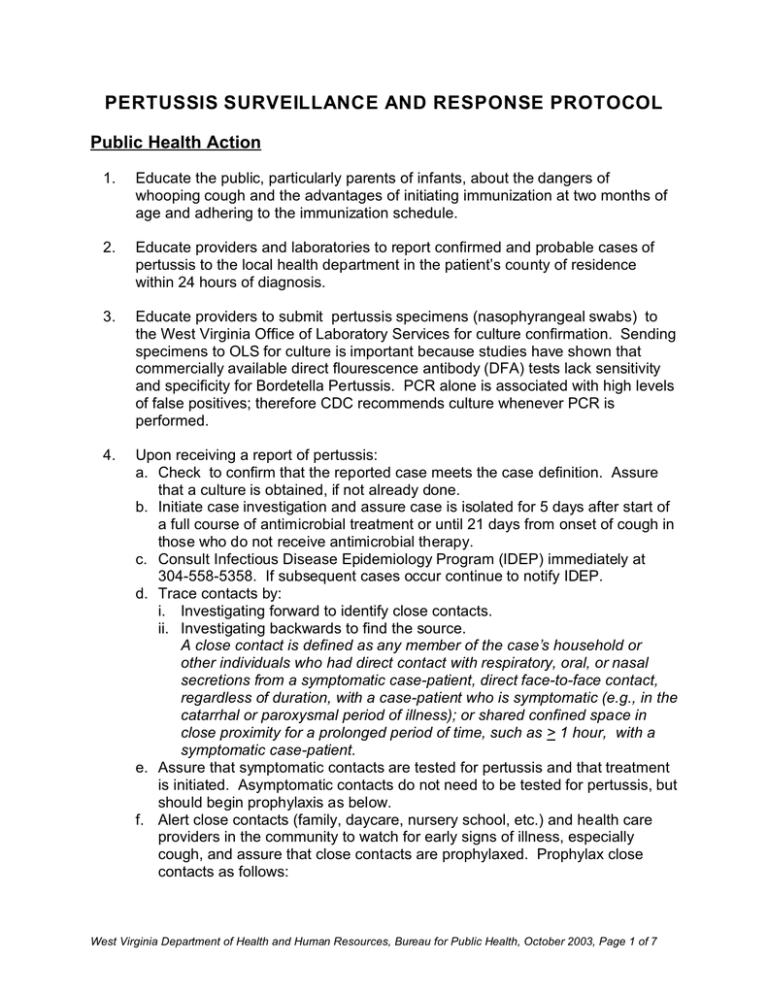
PERTUSSIS SURVEILLANCE AND RESPONSE PROTOCOL Public Health Action 1. Educate the public, particularly parents of infants, about the dangers of whooping cough and the advantages of initiating immunization at two months of age and adhering to the immunization schedule. 2. Educate providers and laboratories to report confirmed and probable cases of pertussis to the local health department in the patient’s county of residence within 24 hours of diagnosis. 3. Educate providers to submit pertussis specimens (nasophyrangeal swabs) to the West Virginia Office of Laboratory Services for culture confirmation. Sending specimens to OLS for culture is important because studies have shown that commercially available direct flourescence antibody (DFA) tests lack sensitivity and specificity for Bordetella Pertussis. PCR alone is associated with high levels of false positives; therefore CDC recommends culture whenever PCR is performed. 4. Upon receiving a report of pertussis: a. Check to confirm that the reported case meets the case definition. Assure that a culture is obtained, if not already done. b. Initiate case investigation and assure case is isolated for 5 days after start of a full course of antimicrobial treatment or until 21 days from onset of cough in those who do not receive antimicrobial therapy. c. Consult Infectious Disease Epidemiology Program (IDEP) immediately at 304-558-5358. If subsequent cases occur continue to notify IDEP. d. Trace contacts by: i. Investigating forward to identify close contacts. ii. Investigating backwards to find the source. A close contact is defined as any member of the case’s household or other individuals who had direct contact with respiratory, oral, or nasal secretions from a symptomatic case-patient, direct face-to-face contact, regardless of duration, with a case-patient who is symptomatic (e.g., in the catarrhal or paroxysmal period of illness); or shared confined space in close proximity for a prolonged period of time, such as > 1 hour, with a symptomatic case-patient. e. Assure that symptomatic contacts are tested for pertussis and that treatment is initiated. Asymptomatic contacts do not need to be tested for pertussis, but should begin prophylaxis as below. f. Alert close contacts (family, daycare, nursery school, etc.) and health care providers in the community to watch for early signs of illness, especially cough, and assure that close contacts are prophylaxed. Prophylax close contacts as follows: West Virginia Department of Health and Human Resources, Bureau for Public Health, October 2003, Page 1 of 7 Dose for Treatment or Prophylaxis DRUG Erythromycin CHILD 40-50 mg/kg per day orally in 4 divided doses; (maximum, 2 g/day) for 14 days, as tolerated. ADULT 1-2 grams/day orally in 4 divided doses for 14 days (maximum 2g/day) -ORTrimethoprim (T) / Sulfamethoxazole (S) (Bactrim)* 8 mg/kg/day (T) and 40 mg/kg/day (S) orally in two divided doses for 14 days. 320mg/day (T) and 1600mg/day (S) orally in two divided doses for 14 days. Erythromycin a macrolide antibiotic, has been successful in rapidly clearing B. pertussis from the nasopharynx and has been the antimicrobial agent of choice for the treatment of pertussis. (CDC) If contacts meeting prophylaxis guidelines are unable to obtain Erythromycin by any other means due to financial circumstances, the state health department should be contacted at 304-558-5358. The state health department will dispense erythromycin out of its stock after consulting with the infectious disease epidemiologist on call. * Because of the risk of kernicterus (a condition with severe neural symptoms, associated with high levels of bilirubin in the blood). TMP-SMZ should not be given to pregnant women at term, nursing mothers, or infants aged <2 months. Studies suggest that the newer macrolides, azithromycin (10-12 mg/kg per day, orally, in 1 dose for 5 days; maximum 600 mg/day) or clarithromycin (1520 mg/kg per day, orally, in 2 divided doses; maximum, 1 g/day for 7 days), may be as effective as erythromycin and have fewer adverse effects and better compliance. Resistance to erythromycin (and other macrolide antimicrobial agents) by B. pertussis has been reported rarely. Penicillin and first- and second-generation cephalosporins are not effective against B pertussis. g. Exclude all cases and symptomatic contacts from day care, school, and work for the first five days of a full course of antimicrobial treatment or for 21 days from onset of cough in those who do not receive antimicrobial therapy. h. Monitor close contacts for respiratory symptoms that develop within 21 days of last contact with a case. Each symptomatic contact should be evaluated medically and epidemiologically with respect to the etiology and potential for transmission to susceptibles. Conduct follow-up interviews for the following: West Virginia Department of Health and Human Resources, Bureau for Public Health, October 2003, Page 2 of 7 i. i. 5. Reported suspected, probable, or confirmed pertussis cases to determine whether they meet the clinical case definition; ii. Symptomatic contacts who coughed less than 14 days at the time of the initial interview to determine whether they meet the clinical case definition; iii. Asymptomatic contacts 21 days following their exposure to determine whether they have remained disease-free. Complete the front and back of the yellow card. Investigate using the CDC pertussis form. Document prophylaxis and attach copies of laboratory reports. Forward all paperwork to Infectious Disease Epidemiology Program (IDEP). Assess the immunization status of close contacts under age seven. Contacts who are less than seven years of age and are not immunized or have received fewer than 4 doses of DTP or DTaP should, in addition to receiving antibiotic prophylaxis, have pertussis immunization initiated or continued according to the following: • • • • • Give 1st dose at > 6 weeks of age; doses 1, 2, 3 must be separated by at least 4 weeks. Children who received their third dose of DTP/DTaP > 6 months before exposure should receive a fourth dose. Children who received 4 doses of DTP/DTaP should get a booster of DTP/DTaP, unless a dose has been given in the last three years or they are 7 years of age or older. Children with a well-documented pertussis disease (e.g., positive culture for B pertussis or epidemiologic linkage to a confirmed culture-positive case) should complete the immunization series with at least DT; some experts recommend DTaP. Although well-documented pertussis disease is likely to confer immunity against pertussis, the duration of such immunity is unknown. All children should be brought up-to-date and maintained up-to-date as appropriate for age. Disease Prevention Objectives Prevent cases of disease by encouraging full immunization of all children per the ACIP approved schedule. Disease Control Objectives Prevent secondary cases by: 1. Assuring the case is placed in droplet isolation until five days after the start of a full course of antimicrobial treatment or until 21 days after cough onset in those who do not receive antimicrobial therapy. 2. Early identification and prophylaxis of close contacts to cases. West Virginia Department of Health and Human Resources, Bureau for Public Health, October 2003, Page 3 of 7 Disease Surveillance Objectives 1. To determine the incidence of pertussis in West Virginia; 2. To determine whether cases are due to failure to vaccinate or vaccine failure; 3. To identify sources and sites of transmission; 4. To identify probable cases (symptomatic individuals epidemiologically-linked to a confirmed case); 5. To monitor the effectiveness of outbreak control strategies. Public Health Significance Pertussis is a major cause of childhood morbidity and mortality. An estimated 45 million cases and 400,000 deaths occur annually. Case fatality rates in developing countries can reach 15%. High routine coverage with effective vaccine is the mainstay of prevention. Surveillance data enables monitoring of the impact of immunization programs, as well as identifies high risk areas, age groups for targeted immunization, and outbreaks. Pertussis, or whooping cough, is an acute infectious disease caused by the bacterium Bordetella pertussis. Outbreaks of pertussis were first described in the 16th century, and the organism was first isolated in 1906. In the 20th century pertussis has been one of the most common childhood diseases and a major cause of childhood mortality in the United States. Prior to the availability of pertussis vaccine in the 1940s, over 200,000 cases of pertussis were reported annually. Since widespread use of the vaccine began, incidence has decreased more than 98%, to an average of about 4,400 cases per year since 1980. Clinical Description Whooping cough usually starts with cold or flu-like symptoms, such as runny nose, sneezing, fever and a mild cough. These symptoms can last up to two weeks and are followed by increasingly severe coughing spells. Fever, if present, is usually mild. The clinical course of the illness is divided into three stages: Catarrhal Stage: Characterized by insidious onset of coryza ( runny nose), sneezing, low grade fever, and a mild, occasional cough, similar to the common cold. The cough gradually becomes more severe, and after 1-2 weeks, the second or paroxysmal stage, begins. Paroxysmal Stage: Characterized by bursts, or paroxysms of numerous, rapid coughs, apparently due to difficulty expelling thick mucous from tracheobronchial tree. At the West Virginia Department of Health and Human Resources, Bureau for Public Health, October 2003, Page 4 of 7 end of the paroxysm, a long inspiratory effort is usually accompanied by a characteristic high pitched whoop. During such an attack, the patient may become cyanotic (turn blue). Vomiting and exhaustion commonly follow the episode. The patient usually appears normal between attacks. The paroxysmal stage usually lasts 1 to 6 weeks, but may persist up to 10 weeks. Convalescent Stage: Characterized by gradual recovery. The cough becomes less paroxysmal and disappears over 2-3 weeks. However paroxysms often recur with subsequent respiratory infections for many months after the onset of pertussis. Older persons (i.e., adolescents and adults), and those partially protected by the vaccine, may become infected with B. Pertussis, but usually have milder disease. Pertussis in these persons may present as a persistent (<7 days) cough, and may be indistinguishable from other upper respiratory infections. Etiologic Agent Bordetella Pertussis, a fastidious, gram-negative, pleomorphic bacillus. Reservoir Pertussis is a human disease. No animal or insect source or vector is known to exist. Mode of Transmission Pertussis is transmitted person-to-person by direct or droplet contact with nasopharyngeal secretions of an infected person. Incubation Period The incubation period of pertussis is commonly 7-10 days, with a range of 4-21 days. Infectious Period An infected person can transmit the disease from 2 weeks before to 3 weeks after cough onset. If treated with appropriate antibiotics, the person is considered infectious through the 5th day of treatment. Outbreak Recognition Outbreak is defined as two or more cases involving two or more households clustered in time and space where transmission is suspected to have occurred (e.g. a school). One case in an outbreak must be lab confirmed (PCR positive and meets case definition, or culture positive). In outbreak settings a case may be defined as a cough illness lasting 14 days or more. West Virginia Department of Health and Human Resources, Bureau for Public Health, October 2003, Page 5 of 7 Case Definition for Pertussis Clinical case definition A cough illness lasting greater than or equal to 2 weeks with one of the following: paroxysms of coughing, inspiratory "whoop," or post-tussive vomiting, without other apparent cause Laboratory criteria for diagnosis • Isolation of Bordetella pertussis from clinical specimen or • Positive polymerase chain reaction (PCR) for B. pertussis Case classification Probable: a case that meets the clinical case definition, is not laboratory confirmed, and is not epidemiologically linked to a laboratory-confirmed case Confirmed: a case that is laboratory confirmed or one that meets the clinical case definition and is either laboratory confirmed or epidemiologically linked to a laboratory-confirmed case Comment: The clinical case definition is appropriate for endemic or sporadic cases. In outbreak settings, a case may be defined as a cough illness lasting greater than or equal to 2 weeks. Because some studies have documented that direct fluorescent antibody testing of nasopharyngeal secretions has low sensitivity and variable specificity, it should not be relied on as a criterion for laboratory confirmation. Serologic testing for pertussis is available in some areas, but is not standardized and, therefore, should not be relied on as a criterion for laboratory confirmation for national reporting purposes. Both probable and confirmed cases should be reported to IDEP. Laboratory Diagnosis of Pertussis The standard and preferred laboratory test for diagnosis of pertussis is isolation of Bordetella Pertussis by bacterial culture. All suspected cases of pertussis should have a nasopharyngeal aspirate or swab obtained for culture from the posterior nasopharynx. The direct immunofluorescence assay (DFA) of nasophyrangeal secretions is not a reliable criterion for laboratory confirmation of diagnosis. DFA has variable sensitivity and low specificity and cross reactions with normal nasophyrangeal flora account for false-positive results in upto 85% of tests leading to substantial unnecessary public health intervention. Numerous studies have demonstrated the potential for PCR assays to detect Bordetella cells with greater sensitivity and more rapidly than culture. However, no specific technique for PCR is universally accepted or validated among laboratories and the correlation between PCR results and disease is not well established. The CDC recommends culture whenever PCR is performed. West Virginia Department of Health and Human Resources, Bureau for Public Health, October 2003, Page 6 of 7 Surveillance Indicators • • • • • Proportion of confirmed cases with laboratory confirmation. Proportion of investigations with complete demographic information. Proportion of probable or confirmed cases reported with complete vaccination history recorded. Proportion of cases with contacts identified Proportion of mean/median contacts per case. West Virginia Department of Health and Human Resources, Bureau for Public Health, October 2003, Page 7 of 7
